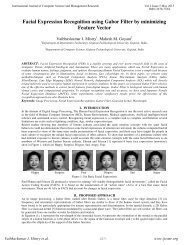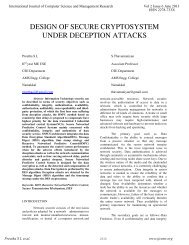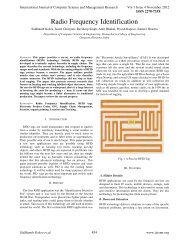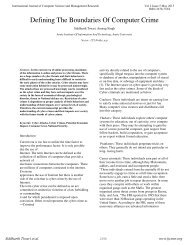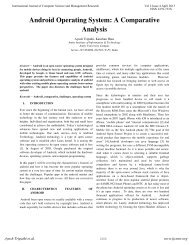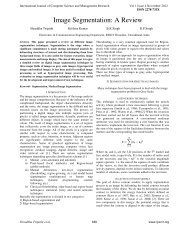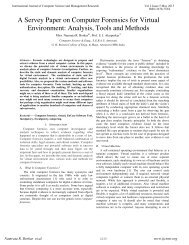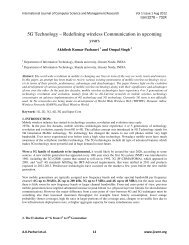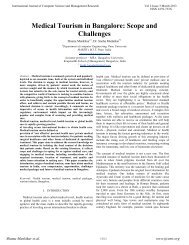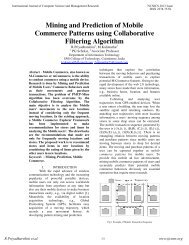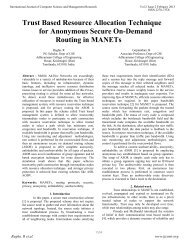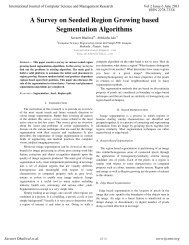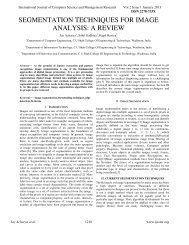A Square Root Topologys To Find Unstructured Peer-To ... - ijcsmr
A Square Root Topologys To Find Unstructured Peer-To ... - ijcsmr
A Square Root Topologys To Find Unstructured Peer-To ... - ijcsmr
- No tags were found...
You also want an ePaper? Increase the reach of your titles
YUMPU automatically turns print PDFs into web optimized ePapers that Google loves.
International Journal of Computer Science and Management Research Vol 2 Issue 3 March 2013ISSN 2278-733Xperformance analysis shows that P2P networks. thesearch path length is OðN c2 Þ (where 0 < c2 < 1)if any peer i on the path has to search another peer j,which is to be same as to the destination peer d thani, to receive and forward the query toward d. fromhaving a best performance analysis, our theoreticalanalysis is existed in simulations. we compare ourproposal with two representative distributedalgorithms. With our similarity-aware searchprotocol, that the overlay networks that shows thesimilarity of participating peers can considerablydicrease the query traffic and the search protocolbased on blind flooding.2. Our Proposal: The <strong>Square</strong>-<strong>Root</strong><strong>To</strong>pologyA peer-to-peer network with N peers. Each peer kin the network has degree dk . The total degree inthe network is D, whereD =_Nk=1 dk.Equivalently , the total number of connections inthe network is D/2. We used the square-roottopology as a topology where the degree of eachpeer is proportional to the square root of thepopularity of the peer’s content. if we define gk asthe proportion of searches submitted to the systemthat are satisfied by content at peer k, then a squareroottopology has dk √ gk for all k. consider auser submits a search s that is existed by the bycontent at a particular peer k. Until the search isprocessed by the network, we do not know whichpeer k is. How many hops will the search messagetake before it arrives at k. The expected length ofthe random walk depends on the degree of k:Lemma 1. If the network is connected and nonbipartite,then the expected number of hops forsearch s to reach peer k is D/dk.where the probability of transition from state i tostate j depends only on i and j, and not on any otherhistory about the process. The states of the Markovchain are the peers in the system, and 1 ≤ i, j ≤ N.Associated with a Markov chain is a transitionmatrix T that shows the probability that a transitionoccurs from a state i to another state j. thistransition probability is the probability that a searchmessage that is at peer i is next sends to peer j. Withrandom walks, the transition probability from peer ito peer j is 1/di if i and j are neighbors, and zero. itdepends only on the node degrees, and not on thestructure. the expected length of a walk does notdepend on which peers are connected to whichother peers. This property exicutes from the factthat the Markov chain converges to the samestationary distribution of which vertices areconnected.Thismodel shows peers forward search messages toa randomly chosen peers, even if that searchmessage has just come from that neighbor or hasalready visited this neighbor. This processsimplifies the Markov chain analysis. Already usedprocess for random walks have noted that avoidingpreviously visited peers can improve the efficiencyof walks, and we state this possibility in simulationresults in the next section. Using the transitionmatrix, we can calculate the probability that asearch message is at a given peer at a given point intime. First, we define an N element vector V0,called the initial distribution vector, the kth entry inV represents the probability that a random walksearch starts at peer k. The entries of V sum to 1.Given T and V0, we can calculate V1, where the kthentry represents the probability of the search beingat peer k after one hop, as V1 = TV0. In general, thevector Vm, representing the probabilities that asearch is at a given peer after m hops, is recursivelydefined as Vm = TVm−1. Under the conditions ofthe lemma, Vm converges to distribution vector Vs,representing the probability that a random walksearch visits a given peer at a particular point intime. It shown that the kth entry of Vs is dk/D. Inthe steady state, the probability that a searchmessage is at a given peer k is dk/D.The search routing as a series of experiments, bychoosing a random peer k from the population of Npeers with probability dk/D. The successfulexperiment occurs when a search chooses a peerwith matching content. The expected number ofexperiments before the search message successfullyreaches a particular peer k is a geometric randomvariable with expected value 1 dk/D = D dk. This isthe result comes by Lemma 1.If a given search requires D/dk hops to reach peer k,we assume that a search will be satisfied by a singlepeer. We define Gk to be the probability that peer kis the goal peer, gk ≥ 0 and _N k=1 gk = 1. The gkvary from peer to peer. The proportion of searchesseeking peer k is gk, The expected number of hopsthat will be taken by peers seeking peer k is D/dk,The expected number of hops taken by searches is:H = _N k=1 gk D dk (1)It turns out that H is minimized when the degree ofa peer is proportional to the square root of thepopularity of the documents at that peer. This is thesquare-root topology.Theorem 1:H is minimized when dk = D √ gk _N i=1 √ gi (2)・Proof:D. Raman et.al. 1732www.<strong>ijcsmr</strong>.org




